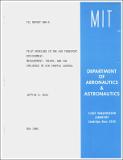| dc.contributor.author | Katz, Jeffrey G. | en_US |
| dc.contributor.other | Massachusetts Institute of Technology. Flight Transportation Laboratory | en_US |
| dc.date.accessioned | 2012-01-06T06:48:06Z | |
| dc.date.available | 2012-01-06T06:48:06Z | |
| dc.date.issued | 1980 | en_US |
| dc.identifier | 09440141 | en_US |
| dc.identifier.uri | http://hdl.handle.net/1721.1/67943 | |
| dc.description | May 1980 | en_US |
| dc.description | Includes bibliographical references (p. 185-188) | en_US |
| dc.description.abstract | The operating environment of an air transport crew is characterized by multiple interrupting tasks, these tasks being composed of a mixture of purely physical control and purely mental planning processes. Measurement of crew workload is thus d difficult undertaking due to the necessity to resolve workload contributions imposed by several sources. These sources include physical efforts, mental efforts, random task interruptions, and emotional disturbances. A multiattribute, subjective opinion rating scale is presented for usa as an effective measure for this air transport cockpit environment. An analysis is performed which indicates that a major component of workload is induced by the federal air traffic control system. Mechanizations of this loading inClude speed and altitude restrictions imposed by regulation, confinement and restraint imposed by the structure of the National Airspace System, and loads induced by a stochastic interruption process associated with ATC voice communications, In fact, the analysis of a routine transport arrival into Boston's Logan airport indicates that the (primarily system induced) workload levels in the terminal area, may be higher than the (primarily aircraft induced) workload levels on final approach. A fixed base, Boeing 707 simulator was employed to investigate the consistency, sensitivity, and acceptability- of the 31, subjective rating scale. Four airline pilots and four general aviation, IFH pilots flew a series of routine, MI2 arrivals from high altitude cruise into Boston's Logan airport, each arrival terminating with a standard instrument approach. Consistent ratings were achieved across the airline subjects for all segments of the arrivals. In general, all subjects seemed receptive to the subjective assessment methodology. | en_US |
| dc.format.extent | ii, 238 p | en_US |
| dc.publisher | Cambridge, Mass. : Massachusetts Institute of Technology, Flight Transportation Laboratory, [1980] | en_US |
| dc.relation.ispartofseries | FTL report (Massachusetts Institute of Technology. Flight Transportation Laboratory) ; R80-3 | en_US |
| dc.subject | Air pilots | en_US |
| dc.subject | Aeronautics, Commercial | en_US |
| dc.subject | Air traffic control | en_US |
| dc.title | Pilot workload in the air transport environment : measurement, theory, and the influence of air traffic control | en_US |
| dc.type | Technical Report | en_US |
